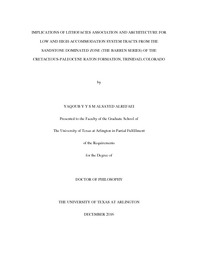| dc.contributor.advisor | Nestell, Merlynd K. | |
| dc.contributor.advisor | Holbrook, John | |
| dc.creator | Alrefaei, Yaqoub Y Y S M Alsayed | |
| dc.date.accessioned | 2017-02-14T16:47:33Z | |
| dc.date.available | 2017-02-14T16:47:33Z | |
| dc.date.created | 2016-12 | |
| dc.date.issued | 2017-01-02 | |
| dc.date.submitted | December 2016 | |
| dc.identifier.uri | http://hdl.handle.net/10106/26443 | |
| dc.description.abstract | The Raton Formation is an Upper Cretaceous and Lower Paleocene unit that is interpreted to be deposited in various stages of high-accommodation fluvial systems. High-accommodation flood basin deposits are generally considered poor as reservoir bodies because sand bodies within these basins are considered to be small and disconnected within flood basin mud. Accordingly, they gain less attention in oil and gas exploration and in research. High-accommodation deposits in the Raton Formation contain several sand bodies with different sizes and geometries that could be good candidates for reservoir rocks. These sand bodies are common in outcrops of high-accommodation deposits in the Raton Formation. The size and distribution of these sand bodies reflect a range of processes spanning different stages of accommodation. Six change-overs within low and high accommodation stages are herein proposed. Two fundamental distinctions in process types are native to low-accommodation systems, and four are native to high-accommodation systems. Low-accommodation systems can be broken into: 1) progressive stacked and 2) iterative stacked end members, whereas high-accommodation systems can be broken into 1) well-drained avulsive distributive, 2) well-drained bifurcating distributive, 3) poorly drained distributive, and 4) fluvio-lacustrine. These subdivisions reflect the progressive intensity of relative accommodation rate against sediment supply. All of these subdivisions have fundamentally different architecture and lithofacies associations, reflecting their differing origins that impact reservoir architecture, particularly in the size arrangement of channel-belts and the connecting units within the flood basin deposits. Careful descriptions of these types of systems will enhance better predictability of reservoir distribution and connectivity and potentially will suggest a new opportunities for oil and gas exploration in high-accommodation systems which otherwise have been overlooked because of low net/gross ratio condition. | |
| dc.format.mimetype | application/pdf | |
| dc.subject | Fluvial | |
| dc.subject | High accommodation | |
| dc.subject | Sedimentary | |
| dc.subject | Stratigraphy | |
| dc.subject | Raton Formation | |
| dc.subject | Raton Basin | |
| dc.subject | Cretaceous | |
| dc.subject | Paleocene | |
| dc.title | IMPLICATIONS OF LITHOFACIES ASSOCIATION AND ARCHITECTURE FOR LOW AND HIGH-ACCOMMODATION SYSTEM TRACTS FROM THE SANDSTONE DOMINATED ZONE ( THE BARREN SERIES) OF THE CRETACEOUS-PALEOCENE RATON FORMATION, TRINIDAD, COLORADO | |
| dc.type | Thesis | |
| dc.contributor.committeeMember | Wickham, John | |
| dc.degree.department | Earth and Environmental Sciences | |
| dc.degree.name | Doctor of Philosophy in Earth and Environmental Science | |
| dc.date.updated | 2017-02-14T16:47:33Z | |
| thesis.degree.department | Earth and Environmental Sciences | |
| thesis.degree.grantor | The University of Texas at Arlington | |
| thesis.degree.level | Doctoral | |
| thesis.degree.name | Doctor of Philosophy in Earth and Environmental Science | |
| dc.type.material | text | |
| dc.creator.orcid | 0000-0002-4373-259X | |

